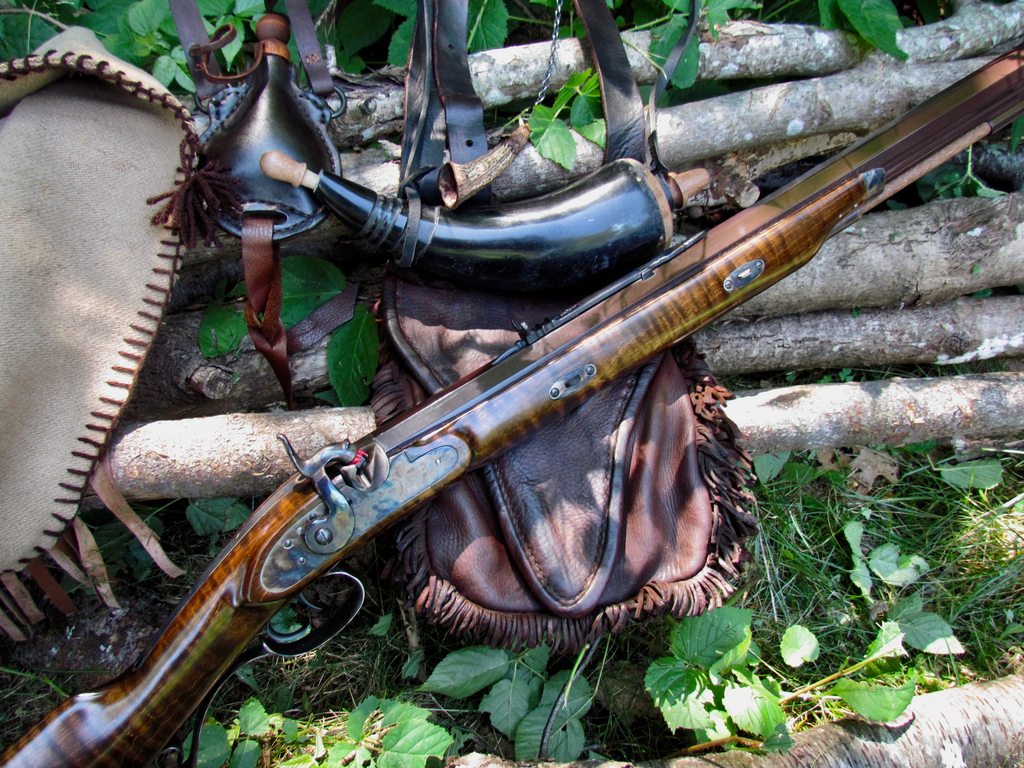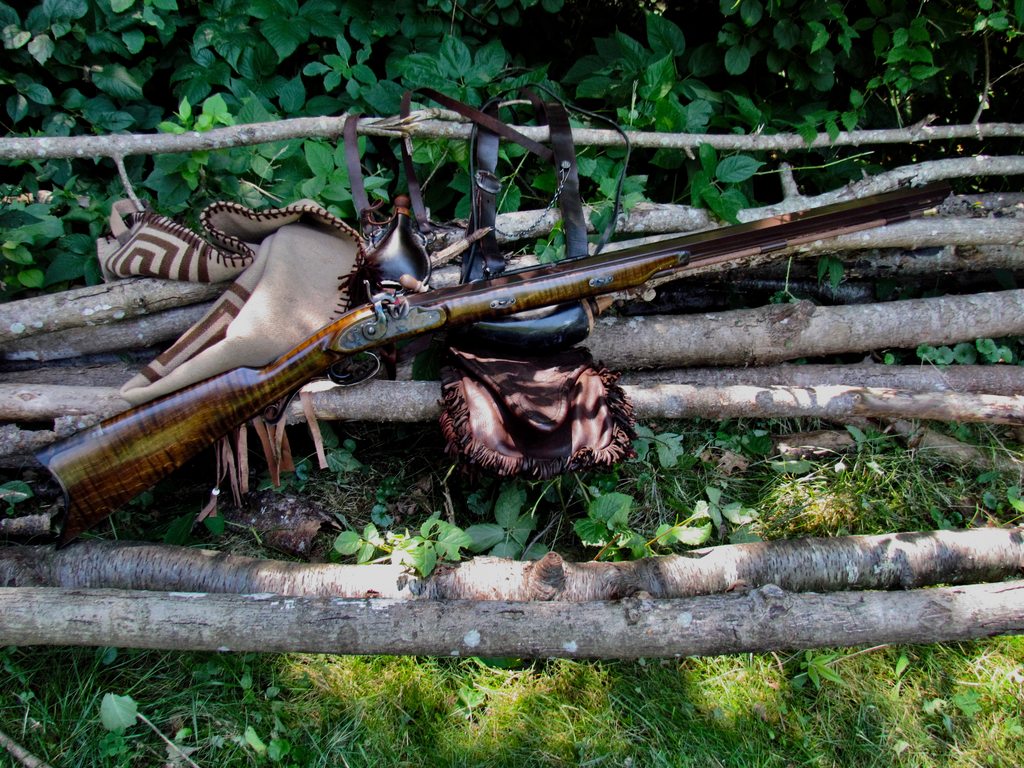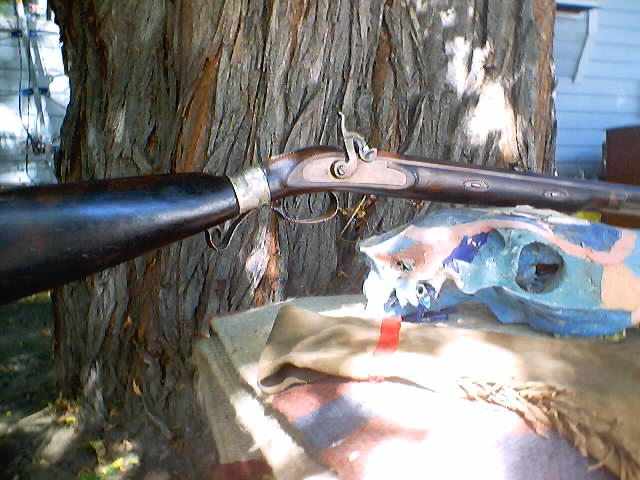Ruxton, Brewerton, Captain Marcy, Matthew Field, Bill Hamilton and likely some others mentioned Hawken rifles in their memoirs or chronicles of the early western frontier, although even the well-educated fellows often spelled the name as "Hawkins." Considering that firearms originating from the Hawken shop had
HAWKEN stamped clearly on the top barrel flat, we wonder if the Hawken name could have possibly become an eponym, a name originally associated with a specific item but then evolving to apply to a whole class of similar items. Like "Kleenex" or "Levi's" are actually individual brand names, but some people apply them to all brands of similar tissues or blue jeans, respectively. In this case, maybe any heavy, well-made mountain rifle
might have been called a "Hawkins." I can't cite the source, but as an example I remember reading an article many years ago that stated, "Kit Carson's Hawken was made by Benjamin Mills of Harrodsburg, Kentucky."
Vaughn Goodwin wrote a very good article about tracking down Tom Tobin's Hawken. You can read the article here:
My Hunt for the Tom Toben Rifle The first rifle he found, which had impeccable provenance in a chain of custody leading directly back to Tom Tobin, was called a "Hawken" by its 20th century owner, but Goodwin documented a heavy, half-stocked plains rifle clearly marked "Birringer" on the top flat. This photo is from that article.
Birringer (sometimes spelled "Biringer") was a gunsmith in Leavenworth, Kansas. He built very good guns, but they were not Hawkens, despite what the owner of Tobin's rifle thought. The Kansas State Historical Society has a good article about him online:
John Biringer's Gunsmithing Tools Anyway, we wonder if the name "Hawkins" might have been applied to plains or mountain rifles made by other builders "back in the day," too, and not just now.
Tom Toben (or Tobin) surely must have owned several rifles in his lifetime, and old photographs clearly show him holding a Hawken:
Goodwin did eventually locate it, as told in the article linked above.
It seems peculiar to me that so many of us cut the "mountain man era" off at 1840, the year of the last major rendezvous. I understand the reasoning, but several of our most beloved mountain man resources were written years later. Ruxton, Garrard, and Parkman were not even in the mountains until 1846. The mid-20th century artist, writer, and Hawken enthusiast, John Barsotti, wrote and illustrated a two-part article entitled "Mountain Men and Mountain Rifles," published in the 1954 and 1955 issues of
Gun Digest. I think this article probably formed an early association between mountain men and Hawken rifles in the minds of 20th century shooters, and the association was cemented by John Baird in his series of articles which formed the book,
Hawken Rifles: The Mountain Man's Choice. Baird and Barsotti knew each other. This painting is an example of Mr. Barsotti's work:
There could have very well been some Hawkens at the last few rendezvous. We know for certain that mountain men Mariano Modena, Jim Bridger, and Christopher Carson owned Hawken rifles, but probably after the rendezvous era. Jacob Hawken died in 1849, and the business was carried on by brother Samuel. Rifles stamped S. HAWKEN, such as the Bridger rifle owned by the Montana Historical Society would necessarily be post-1849, and post-rendezvous. This is the Bridger Hawken:
Getting back to the original question from post #1 as I understand it, in my opinion the Pedersoli Rocky Mountain Hawken is the best and most authentically-constructed
mass marketed Hawken replica. It isn't perfect, but it's the best we have. I would say the Lyman/Pedersoli Great Plains Signature Rifle would be in second place. The only currently available, serious attempt at mass-(re)producing a
non-Hawken original plains rifle that I know of is the Tryon, which is not surprisingly also made by Pedersoli:
For kits or parts sets, The Hawken Shop S. Hawken kit looks like the most faithful to the original. The Don Stith parts sets are said to be equally faithful to the originals, at least in the half-stocked versions. The main problem with percussion Hawken
fullstocks is that the originals were normally made with a solid patent breech, that is, not hooked. I don't think anybody is casting a solid patent breech appropriate for these rifles now. Even the Stith parts sets for percussion fullstocks are only listed with a hook breech at this time. I know there are advantages to a hooked breech, but we are talking about
more authentic replicas, not practical modifications.
For custom builders, the names at the top of the list are Bob Browner, Brant Selb, and John Bergmann. I recently saw a photo of a Hawken by Mike Roby that would put his name up there with the others.
Finally, when questions are posted on this forum, many of the answers will be opinions. Those are mine, and someone else's may be different. We talk about "the Hawken Craze" of the late sixties, seventies, and early eighties, but it never really ended. There are plenty of long-time Hawken nuts alive and well to this day.
Respectfully,
Notchy Bob















